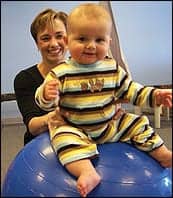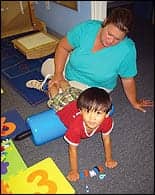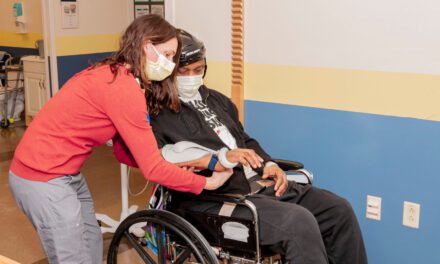 |
| Kelly Heintz, MPT, works with an infant with torticollis on balance and righting reactions. |
One of the most rewarding aspects of daily life is doing what you love and loving what you do. This is especially the case for the hard-working therapists focusing on pediatric rehabilitation, and it is no different for those working at Neurodevelopmental Therapy Services Inc (NTS) who provide physical, occupational, speech, and massage therapy for children with disabilities.
NTS, a private pediatric therapy practice with four clinics in the Houston area, has been around since 1985 when occupational therapist Carol Parker expanded her business from a home health care model in her home to the original clinic she converted from a day care center. The clinics take an innovative approach to pediatric rehabilitation to help their patients improve cognitive and communication skills, dexterity and motor skills, as well as strength, coordination, and endurance for their everyday lives. Parker helps facilitate the therapists’ education by encouraging them to get training and certifications in multiple fields.
“One of the things that I feel she does best is every therapist that works for her is required to mentor and teach other therapists within the organization,” says Sharron Reilly, OTR, clinical director for NTS Northwest. “She allows and pays for the time for therapists to train each other. It helps the entire organization stay on the cutting edge.”
KEEPING THE JOB IN FOCUS
Reilly says the most common cases the Northwest clinic sees are children on the autism spectrum, followed by those with brachioplexus injuries and traumatic brain injury.
Lara Hiers, MPT, clinical director at NTS Southeast, also says her clinic mostly sees patients on the autism spectrum, followed by those with cerebral palsy, and babies with torticollis.
NTS sees patients from as young as several weeks old to well into their 20s and even 30s. With so many different types of patients, both Reilly and Hiers say the therapy depends on the patient, not solely on the diagnosis. However, behavior issues often accompany pediatric therapy.
Keeping any child focused on one task for an extended period of time can be trying, let alone trying to keep a child focused for a 1-hour therapy session. Hiers says the key to pediatric rehabilitation is to keep it fun.
“If you’re working with an adult, you can tell them to do 20 squats to exercise their quadriceps muscles,” she says. “Well, you can’t tell a 4 year old that, even though they need it. They need to strengthen those muscles, but we have to make it into a game. That’s the whole challenge of working with kids, making exercise fun and making it a game.”
One of the techniques that has come in handy in getting a child excited about therapy is actively including them in selecting the types of exercises they will be expected to complete during that session. Reilly says her clinic uses a penny board to give an activity-based reward to a child for sticking with a task.
Another successful technique has been the use of schedules. A child gets to pick from a list of activities what exercises they want to do as a way to get them involved in their therapy.
“We make it their choice and involve them in the process, but at the same time they’re doing the things that we want them to accomplish,” Hiers says.
INNOVATIVE APPROACHES
In addition to physical, occupational, speech, and massage therapy, NTS offers a variety of innovative approaches for pediatric rehab, including Neuro-Developmental Treatment (NDT), integrated gymnastics classes, handwriting groups, therapeutic listening, sensory integration, social motor groups, interactive metronome, computer classes, and aquatic therapy. Many of these therapies are integrated into sessions for children recovering from brain injury, spinal cord injury, and early stroke, as well as for children with other disabilities.
 |
| Lara Hiers, MPT, works with a 4-year-old boy in prone over a bolser to strengthen the shoulder girdle, trunk, and neck. The letters are used as motivation to keep him in the position. |
Hiers says children with neurological disorders can benefit from NDT, a hands-on approach in working with patients who have motor control difficulties.
“NDT involves a problem-solving approach that allows for a wide variety of strategies that are flexible enough to be adapted to the impairment of each individual client,” Parker says. “With a ‘hands on’ approach, the therapist ‘feels’ and discerns which movement patterns are missing from the clients functional skills. These missing motor patterns are then introduced through movement experiences and through practice are repeatedly built into the client’s experience of movement. The goal of the therapist is to assist the child in being an active problem-solver of their own movements.”
A major approach NTS uses is sensory integration, where the therapist tries to improve the child’s movement by addressing different aspects of their sensory system. For example, some children could be very sensitive to different textures.
“Some kids don’t want to walk in the grass or some kids don’t like the tags in their clothing,” Hiers says. “They’re just extrasensitive to textures. We expose them to different textures that will hopefully make them not as sensitive.”
With therapeutic listening, children wear headphones and listen to modulated music while doing therapy. The listening impacts the vestibular systems located in the inner ear. The vestibular system is responsible for movements, balance and equilibrium reactions as detected by movements of the head. It is also connected to the arousal and alertness levels, muscle tone and coordination, which impacts motor skills, learning, posture, attention spans, speech, and language as well as auditory processing.
“A lot of times these kids have trouble listening and paying attention, and the therapeutic listening is supposed to help them filter sounds in the environment so they can focus better and pay attention better,” Hiers says.
Computer classes offer pediatric patients the opportunity to interact with a popular form of modern technology. Because children are attracted to the light and sound of computer programs, it is an innovative technique in getting children interested in their therapy sessions. The computer may challenge pediatric patients’ cognitive ability, as well as hand-eye coordination. Tools such as joysticks, a mouse mover, or five-finger keyboards allow children to fully interact with this medium, as well as teach them key skills for operating such environmental controls in their homes.
PARENTAL INVOLVEMENT
A big key to getting the therapy to work is more than the child just showing up and participating in the scheduled sessions. Active parental involvement allows the therapists to explain what they are doing during therapy and why they are doing it. This also allows the therapists to explain how the activities the child does in therapy will help the child at home.
“When the parent is involved, we can not only explain what we are doing, what is the science behind what we are doing, but how we can help the child at home,” Reilly says. “I insist that parents be a part of my sessions unless there’s just some reason that it cannot happen.”
Hiers agrees. She says that no matter what they do in therapy, the therapists see the child only for a limited amount of time. Even if a child comes in 3 hours a week, that is minimal compared to the time the parents spend with the child.
“Demonstration and return demonstration is an important parent learning strategy,” Parker says. “If parents are comfortable with the skills and knowledge we impart upon them, this becomes a win-win situation. Functional skills, quality of movement, and repeated movement experiences are a life long process for our clients. Involvement of parents and caregivers is so vital to the progress of our children; perhaps it could be the most important aspect of what we do.”
Morgan Saffari is associate editor of Rehab Management.



